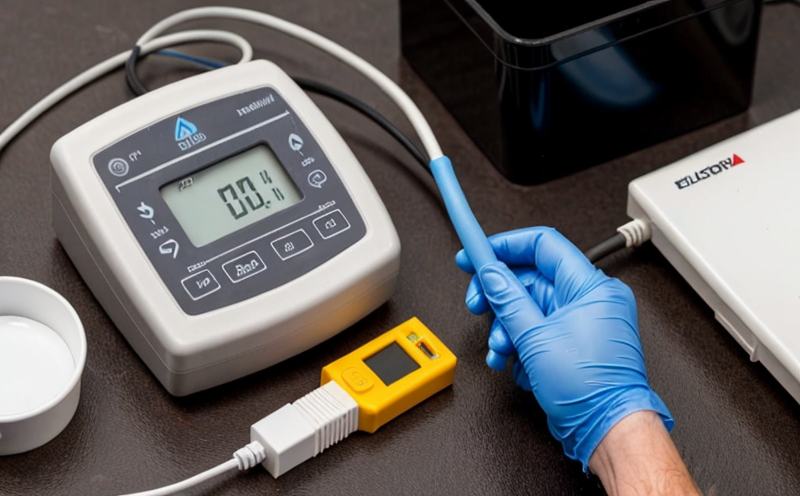EN 13509 Electrochemical Measurement of Cathodic Protection
The EN 13509 standard specifies the electrochemical measurement methods used in determining the cathodic protection (CP) performance of steel or iron structures. This method is crucial for ensuring that these structures are adequately protected against corrosion, which can be costly and dangerous if left unchecked.
Cathodic protection is an essential part of infrastructure maintenance across various sectors including oil and gas pipelines, water treatment facilities, and maritime industries. The standard provides a standardized approach to measure CP performance by quantifying the polarization resistance (Rp) and potential difference between the cathode and structure.
The measurement process involves applying a known current density to the protected steel or iron surface while monitoring the resulting potential changes using a potentiostat. This data is then analyzed according to the EN 13509 guidelines to determine if the CP system is functioning effectively.
By adhering to this standard, organizations can ensure that their CP systems are meeting international best practices and regulatory requirements. Regular testing ensures continuous protection against corrosion, thereby extending the operational life of structures and reducing maintenance costs.
The EN 13509 methodology offers several advantages over other forms of corrosion control. It is non-destructive, allowing for real-time monitoring without disrupting ongoing operations. Additionally, it provides precise measurements that can guide adjustments to CP systems as needed.
| Parameter | Description |
|---|---|
| Polarization Resistance (Rp) | The resistance measured between the cathode and structure. Lower values indicate better protection. |
| Potential Difference | The voltage difference between the cathode and protected steel or iron surface. |
Regular testing according to EN 13509 is essential for maintaining effective CP systems. By implementing this standard, organizations can ensure compliance with international regulations while also protecting their assets from corrosion damage.
The following section will explore why such testing is critical in various industries and the potential consequences of neglecting these tests.
Why It Matters
Cathodic protection plays a vital role in preventing metal structures from corroding, which can lead to costly repairs and safety hazards. Regular electrochemical measurements using EN 13509 are necessary to ensure that CP systems are functioning correctly.
- Potential failure of critical infrastructure such as pipelines or offshore platforms.
- Increased maintenance costs due to undetected corrosion.
- Hazardous conditions for workers if structures weaken unexpectedly.
In sectors like oil and gas, where pipelines are exposed to harsh environments, CP systems must be continually monitored. Neglecting these tests can result in catastrophic failures that disrupt operations and endanger lives. For example, a pipeline failure could lead to severe environmental damage or explosions.
Water treatment facilities also rely heavily on CP systems to protect their infrastructure from corrosion. Poorly maintained systems can lead to leaks and contamination issues, compromising the quality of water supplies.
The maritime industry faces unique challenges due to saltwater exposure. Ships' hulls need robust CP systems to prevent corrosion, which is essential for maintaining ship integrity and safety. Without regular testing, these systems may degrade unnoticed, leading to costly repairs or even accidents at sea.
By adhering to EN 13509 standards, organizations can mitigate risks associated with corrosion and ensure the longevity of their metal structures. This not only protects assets but also contributes to environmental sustainability by minimizing waste from premature failures.
Scope and Methodology
The scope of EN 13509 covers the measurement of cathodic protection performance on steel or iron surfaces using electrochemical techniques. The method is applicable for both in-service structures and new installations.
| Methodology Step | Description |
|---|---|
| Preparation | Ensure the surface to be tested is clean, dry, and free from any external influences that could affect the measurement. |
| Application of Current Density | Apply a known current density to the surface using a suitable source. |
| Potentiostat Monitoring | Monitor the resulting potential changes using a potentiostat connected to the cathode and structure. |
The method also includes guidelines for interpreting the data obtained from these measurements. It specifies criteria for determining whether the CP system is effective based on polarization resistance (Rp) values and potential differences.
It's important to note that while EN 13509 provides a standardized approach, it does not specify the exact equipment or techniques to be used. Instead, it allows flexibility within certain parameters to accommodate different testing environments and conditions.
International Acceptance and Recognition
The EN 13509 standard has gained widespread acceptance across Europe and other regions due to its reliability and effectiveness in measuring cathodic protection performance. Many countries have adopted this standard as part of their national regulations for infrastructure maintenance.
- European Union: The EU recognizes the EN 13509 method as a harmonized standard, meaning it is widely accepted within member states.
- Nordic Countries: Norway, Sweden, Finland, and Denmark all use this standard for their infrastructure protection programs.
- United States: While not officially recognized by the U.S., many companies in industries like oil and gas adopt EN 13509 voluntarily due to its practical benefits.
- Australia: Some Australian states have incorporated elements of EN 13509 into their local standards for infrastructure protection.
The international recognition of this standard underscores its importance in ensuring consistent and reliable cathodic protection performance across different regions. By adhering to these guidelines, organizations can ensure that their CP systems meet global best practices and regulatory requirements.





